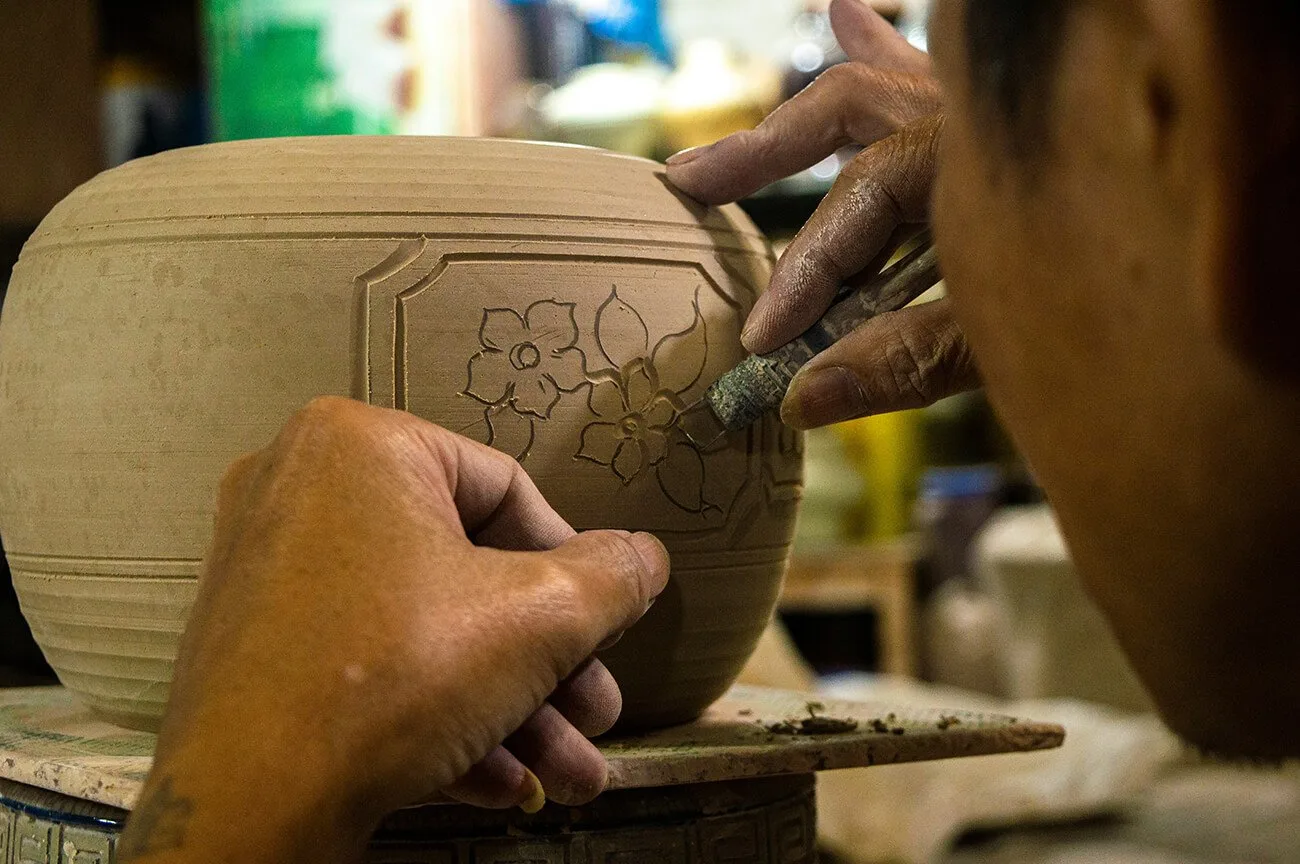News
Dive into the Development of Bat Trang Ceramics through Dynasties
Bat Trang ceramics represent one of Vietnam’s most treasured cultural heritages, embodying centuries of artistic and technical evolution. Originating from Bat Trang village, located just outside Hanoi, these ceramics have thrived through numerous dynastic changes, reflecting shifts in social, economic, and artistic trends. This article explores the fascinating development of Bat Trang ceramics over various Vietnamese dynasties, highlighting their unique styles, production techniques, and cultural significance.
Historical Roots and Early Development of Bat Trang Ceramics

The origins of Bat Trang ceramics date back to around the 14th century during the Ly and Tran dynasties. The foundation laid during this early period set the stage for the village to become a center of ceramic artistry.
Before delving into the detailed progression, it is essential to understand the socio-political backdrop that nurtured the growth of Bat Trang ceramics. During the Ly and Tran eras, Vietnam experienced relative stability and prosperity, encouraging artisans to experiment with pottery techniques and designs.
Origins in the Ly Dynasty
The Ly dynasty (1009–1225) marked a significant era of cultural blossoming in Vietnam. Although little concrete evidence exists about the ceramics specifically from Bat Trang during this time, historical records suggest that pottery traditions were already well-established in the Red River Delta regions.
Pottery in the Ly period was characterized by utilitarian wares and simple decorative elements. The ceramics were primarily functional, serving domestic needs while gradually incorporating aesthetic qualities inspired by contemporary Buddhist art and Chinese influences.
Bat Trang’s location near major river routes allowed for efficient distribution of ceramic products, facilitating early trade and market penetration beyond local boundaries. This strategic position likely played a role in the village’s rise as a ceramic production hub.
Growth under the Tran Dynasty
The Tran dynasty (1225–1400) brought further advancements. Ceramic artisans refined their skills, experimenting with glazing techniques and intricate surface decorations. The use of celadon glaze—a glossy, jade-like green finish—became widespread, inspired by Chinese Song dynasty ceramics but adapted to local tastes.
During this period, Bat Trang artisans began developing distinct motifs, often symbolic or religious, such as lotus flowers, dragons, and phoenixes. These reflected the strong influence of Confucianism and Buddhism on Vietnamese culture.
The Tran dynasty also saw increased demand for both everyday wares and ceremonial objects, pushing artisans to diversify their ceramic offerings. This diversification was crucial for Bat Trang ceramics’ long-term sustainability and reputation.
Establishment of Craftsmanship Foundations
The combined legacy of the Ly and Tran dynasties created a solid foundation for craftsmanship in Bat Trang. Techniques such as wheel-throwing, hand-painting, and glazing were perfected and passed down through generations.
This era set the tone for future innovation, embedding a deep respect for tradition alongside openness to external influences—a balance that would define Bat Trang ceramics throughout history.
Flourishing during the Le and Mac Dynasties

The subsequent Le and Mac dynasties witnessed the peak of Bat Trang ceramics’ artistic and commercial achievements.
As the political landscape stabilized and trade expanded, Bat Trang ceramics entered a golden age marked by exquisite artistry and mass production capabilities.
Artistic Refinement in the Le Dynasty
The Later Le dynasty (1428–1788) is often regarded as the golden era for Vietnamese art and culture. Bat Trang ceramics flourished due to increased royal patronage and growing urban markets.
Ceramic artists honed intricate painting techniques using cobalt blue underglaze, producing vividly decorated pieces that rivaled imported Chinese porcelain in quality. Designs became more sophisticated, featuring elaborate scenes from folklore, nature, and mythology.
The Le dynasty’s stability fostered innovation in kiln technology, improving firing consistency and allowing for larger batch productions without sacrificing quality. This technological progress directly contributed to Bat Trang ceramics gaining broader appeal domestically and internationally.
Expansion and Competition under the Mac Dynasty
The Mac dynasty (1527–1592), although short-lived and politically tumultuous, presented an interesting chapter for Bat Trang ceramics. Despite instability, artisan communities continued their craft, adapting designs to reflect changing tastes.
Under the Mac, there was an influx of foreign influences through maritime trade, including European motifs introduced subtly into ceramic decoration. This blending of styles showcases Bat Trang’s adaptive nature and its artisans’ willingness to embrace new creative ideas.
Competition with other ceramic centers in Vietnam and Asia intensified during this period, pushing Bat Trang to maintain high standards and innovate continuously.
Techniques and Materials Enhancement
During the Le and Mac periods, there was significant improvement in raw material sourcing and preparation, notably in refining clay quality and glaze formulas. Artisans experimented with color palettes and surface textures, creating visually striking and durable ceramics.
These enhancements allowed Bat Trang ceramics to meet rising demands from both aristocratic patrons and burgeoning merchant classes, ensuring the craft’s economic viability.
Adaptation and Challenges in the Nguyen Dynasty and Colonial Era

The Nguyen dynasty (1802–1945) and subsequent French colonial period introduced complex dynamics impacting Bat Trang ceramics, including modernization pressures and global market integration.
Despite challenges, Bat Trang artisans demonstrated resilience, adapting their craft to new social realities while preserving traditional values.
Revival and Innovation under the Nguyen Dynasty
The Nguyen dynasty’s establishment brought political unification and renewed interest in national identity, which influenced artistic expressions across Vietnam.
Bat Trang ceramics during this time balanced classical aesthetics with incremental innovations. New glazes, brighter colors, and mixed styles emerged, reflecting both reverence for heritage and openness to fresh influences.
Royal commissions and temple projects sustained artisan livelihoods, while local markets demanded practical household wares, maintaining a diverse production range.
Impact of French Colonial Rule
French colonization (late 19th to mid-20th century) drastically altered Vietnam’s economic and cultural landscapes.
On one hand, colonial infrastructure improved transportation and export channels for Bat Trang ceramics, expanding international exposure. On the other hand, industrialization and imported European ceramics posed fierce competition, threatening traditional crafts.
Artisans responded by emphasizing the uniqueness of handmade Bat Trang ceramics, leveraging cultural nationalism to preserve their craft. Some workshops incorporated Western motifs and forms, creating hybrid products appealing to colonial and expatriate consumers.
Preservation Efforts and Market Shifts
The colonial era witnessed increasing efforts to document and protect Vietnamese cultural heritage, including Bat Trang ceramics. Scholars and collectors highlighted the historical importance of these ceramics, fostering appreciation amid modernization.
At the same time, market preferences shifted towards cheaper mass-produced goods, pressuring Bat Trang artisans to innovate cost-effectively without compromising quality.
This dual challenge of preservation and adaptation defined Bat Trang ceramics’ trajectory in the early 20th century.
Contemporary Developments and Global Recognition
In recent decades, Bat Trang ceramics have experienced a remarkable revival fueled by cultural pride, tourism, and global interest in traditional crafts.
Modern artisans blend heritage techniques with contemporary design, ensuring the craft remains vibrant and economically sustainable.
Revival through Cultural Initiatives
Vietnam’s post-war cultural policies prioritized safeguarding intangible cultural heritage, supporting crafts like Bat Trang ceramics.
Workshops have been revitalized through government grants, training programs, and community engagement, nurturing new generations of skilled artisans.
Museums and exhibitions showcase Bat Trang ceramics, educating audiences about their historical and artistic value.
Integration of Modern Design and Technologies
Contemporary Bat Trang ceramics often feature innovative forms, colors, and themes catering to modern tastes while respecting traditional methods.
Digital tools assist in design planning and marketing, allowing artisans to reach broader customer bases domestically and internationally.
Collaborations with designers and artists introduce fresh perspectives, enhancing creativity without diluting cultural authenticity.
Global Market and Tourism Impact
Bat Trang has become a prominent destination for cultural tourism, attracting visitors eager to experience authentic Vietnamese craftsmanship firsthand.
Export markets in Asia, Europe, and North America appreciate Bat Trang ceramics for their blend of functionality and artistry.
This global recognition fosters economic opportunities and reinforces the importance of preserving traditional knowledge and skills.
Unique Characteristics and Symbolism in Bat Trang Ceramics
Understanding Bat Trang ceramics requires appreciation not only of technical aspects but also of symbolic meanings embedded in their designs.
These ceramics communicate cultural narratives and philosophical concepts integral to Vietnamese identity.
Iconography and Motifs
Common motifs include lotus flowers symbolizing purity, dragons representing power and protection, and cranes denoting longevity.
Floral patterns, geometric shapes, and calligraphic inscriptions often convey auspicious wishes or moral lessons.
The careful selection and arrangement of these motifs reflect artisans’ deep cultural literacy and spiritual sensibility.
Material and Technique Specificity
Bat Trang ceramics traditionally utilize locally sourced white clay known for fine texture and durability.
Kiln-fired at high temperatures, the ceramics exhibit a characteristic hardness and glossy finish.
Techniques such as underglaze painting, incising, and relief work create tactile and visual depth, distinguishing Bat Trang products.
Role in Vietnamese Culture and Daily Life
Beyond aesthetics, Bat Trang ceramics serve practical functions—tableware, storage jars, ritual vessels—and play roles in ceremonies and festivals.
They embody ancestral wisdom, connecting present users to historical continuity and communal values.
This multifaceted significance enhances the ceramics’ meaning far beyond mere objects.
Table: Summary of Key Dynastic Influences on Bat Trang Ceramics
| Dynasty | Period | Key Developments | Artistic Features | Socio-Economic Context |
|---|---|---|---|---|
| Ly | 1009–1225 | Establishment of pottery tradition | Simple utilitarian forms, Buddhist motifs | Stability fosters craft foundations |
| Tran | 1225–1400 | Introduction of celadon glaze, motif development | Dragon, lotus symbols; religious themes | Growing demand for diverse wares |
| Later Le | 1428–1788 | Peak artistic refinement, cobalt underglaze painting | Complex folk and mythological scenes | Royal patronage and urban market growth |
| Mac | 1527–1592 | Foreign stylistic influences, competitive market | Incorporation of European motifs | Political unrest, artisan adaptability |
| Nguyen | 1802–1945 | Blend of classical and innovative designs | Brighter colors, mixed styles | National unification and patronage |
| Colonial Era | Late 19th–Mid 20th | Exposure to global markets, competition with imports | Hybrid forms integrating Western elements | Infrastructure vs. industrial competition |
| Contemporary | 20th century–now | Revival efforts, modern design integration | Diverse colors, new shapes | Cultural pride, tourism, global demand |
Conclusion
The journey of Bat Trang ceramics through Vietnam’s dynasties reveals a compelling narrative of artistic ingenuity, cultural resilience, and adaptive innovation. From humble beginnings in the Ly dynasty to flourishing peaks in the Le era, and through the challenges of colonial intrusion and modernization, Bat Trang ceramics have remained a vital expression of Vietnamese identity. Today, the fusion of tradition and contemporary creativity ensures that Bat Trang ceramics continue to captivate both national and global audiences, standing as timeless artifacts that honor their rich historical roots while embracing the future.
